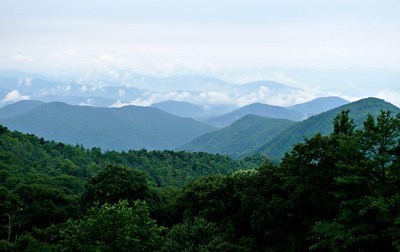Western North Carolina Vitality Index
UNC Asheville's National Environmental Modeling and Analysis Center
Overview
The Mountain Resources Commission (MRC), a non-regulatory organization established by the North Carolina General Assembly in 2009, identified the need to provide local governments with easy-to-understand data specific to the western region of the state in order to encourage more informed decisions with regard to resource use and community planning, and to help the general public understand linkages that may not be readily apparent. They established a partnership with the USDA Forest Service Southern Research Station, the Blue Ridge National Heritage Area, and the National Environmental Modeling and Analysis Center at the University of North Carolina at Asheville to expand the existing Western North Carolina Report Card on Forest Sustainability to include all 27 western counties, incorporating metrics that describe the natural, built, human, and cultural environments that are unique to the western region. The result is the Western North Carolina Vitality Index, a web-based product that is easy to use and free of charge, and that allows users to see either a regional picture or focus on a particular county’s vitality status on a wide variety of issues.
 The WNC Vitality Index will enable the Mountain Resources Commission and many public and private decision makers in the western region to understand the current conditions of our communities and make strategic choices to encourage continued sustainable growth. The metrics illustrate the inter-relationships between our economic conditions, public health, regional traditions, and environmental integrity. Understanding those connections will assist the MRC and others in fulfilling the Commission’s overall mission: “Take care of our natural resources to enhance and sustain quality of life and ensure the long term health of our region and our people."
The WNC Vitality Index will enable the Mountain Resources Commission and many public and private decision makers in the western region to understand the current conditions of our communities and make strategic choices to encourage continued sustainable growth. The metrics illustrate the inter-relationships between our economic conditions, public health, regional traditions, and environmental integrity. Understanding those connections will assist the MRC and others in fulfilling the Commission’s overall mission: “Take care of our natural resources to enhance and sustain quality of life and ensure the long term health of our region and our people."
Our foundation is the natural world we call home, and as humans we establish culture by finding ways to earn a living and coexist with the natural environment. We build our homes, businesses, schools, and roads to support these needs, and our economy needs all of these to remain healthy to work.
To encourage quality growth in Western North Carolina, this regional assessment helps to ensure sufficient management of our many attractive features: our infrastructure, residential and commercial development, food production, energy production, and recreational areas. Balancing these demands of land use is a difficult challenge, but one that must be met in order to sustain the quality of life we enjoy in the communities we call home.
The effort is made to allow planners, decision makers, and the public the information necessary to inspire quality discussion and craft informed decisions on issues affecting Western North Carolina’s abundant natural resources and its potential for sustainable growth. The 27 counties of this report include six Councils of Government: the High Country Council, three counties of the Western Piedmont Council, the Isothermal Planning and Development Commission, the Land of Sky Regional Council, the Southwestern Commission, and two counties of the Piedmont Triad Regional Council.
Preferred citation
"Western North Carolina Vitality Index." Western North Carolina Vitality Index. Mountain Resource Commission, 12 Aug. 2013. Web. <http://www.wncvitalityindex.org/>.

























